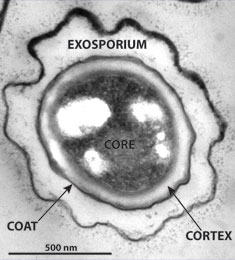Feature Story
Health Center Today, August 25, 2009
Health Center Researcher Awarded Multimillion Dollar Defense Department Grant
By Carolyn Pennington

Bacterial spore image.
Courtesy of Euromed Communications Ltd.
Bacterial spores can be nasty. Just ask Peter Setlow, a professor in the Department of Molecular, Microbial and Structural Biology, who has been studying them for over 40 years. He’ll tell you that spores, such as those of Bacillus anthracis, can cause anthrax. Other bacterial spores are to blame for deadly cases of food poisoning, botulism, and life-threatening infections that are especially hazardous to hospitalized patients. Setlow heads a team of researchers who have been awarded a multimillion dollar grant from the Department of Defense to uncover some of the secrets of spores and potentially make them less dangerous.
“The vegetative organisms cause the disease but it’s the spores that transmit the disease,” explains Setlow. “When they are dormant - it’s like they’re sleeping - they’re very resistant and can survive all kinds of harsh chemical treatments, extremes of temperature and low-nutrient environments. However, once the spores germinate and wake up and come back to life, they are easy to kill. Our research goal is to better understand the mechanisms that spur them to come out of their dormant phase and spring back to life.”
The award is for $1.25 million per year for a total of five years and is a Multidisciplinary University Research Initiative (MURI) grant designed to support basic science and/or engineering research at U.S. institutions of higher education that are of critical importance to national defense. Setlow’s team includes Health Center researchers Bing Hao in the Department of Molecular, Microbial and Structural Biology and Ann Cowan and Ji Yu with the Center for Cell Analysis and Modeling. They will also be collaborating with three other researchers: Jim Faeder at the University of Pittsburgh School of Medicine, Mahfuz Sarker at Oregon State University, and Yong-Qing Li at East Carolina University.
Along with focusing on the mechanisms of spore germination, Setlow and his team are studying their heterogeneity. "It turns out that even though spores may be genetically identical…they don’t all behave identically," says Setlow. During germination, spore number one may come back to life in 5 minutes but spores two, three and four may take their time and not germinate for 30 minutes, 24 hours or up to a month. Setlow says that’s where the problem arises. For example, if you’re being treated for anthrax, how long should you take antibiotics – for a week? Then the spore that germinates in two weeks might kill you.
The same principle applies to food handling. Germinated spores can be killed with high heat; 75 degrees centigrade usually does the trick. But what if that chicken sandwich you’re eating has some spores that were dormant when the chicken was being cooked? Those dormant spores - spores that could potentially transmit botulism toxin - are like bombs waiting to go off.
Setlow believes if his team can figure out why there is this heterogeneity - why one spore germinates fast and the other slow - they might be able to figure out a way to get the spores to all germinate at the same time. An instrument developed by Ji Yu in the Center for Cell Analysis is crucial to this research. Instead of studying whole spore populations, Yu’s apparatus will allow them to look at one spore at a time, how it germinates differently from other spores and perhaps how it differs from other spores in the population.
"If we can better understand this process, maybe we can figure out ways to subvert it, figure out a better way to kill the spores," adds Setlow. "Then there would be big savings in terms of food quality, energy costs, etc, and medical treatments for bacterial diseases could be more effective and potentially life-saving."


